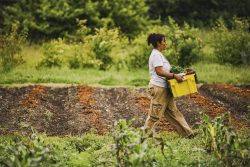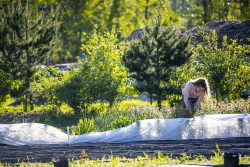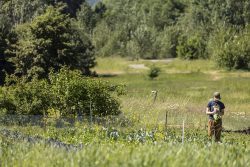
The soil beneath our feet may not often catch our attention, but keeping it healthy can have major impacts on climate change and the overall sustainability of our food production system. A new study of agricultural practices at the UW Farm, led by recent College of the Environment graduate Julia Macray and Professor of Earth and Space Sciences David Montgomery, demonstrated that even relatively small changes to the ways we farm can help restore soil health and sequester carbon from the atmosphere.
“The UW Farm is doing really incredible work, and some very simple agricultural practices have done a lot to improve its soil health,” said Macray, who completed the work as an undergraduate in the Department of Earth and Space Sciences. “It’s an example of the potential for climate remediation and carbon sequestration on a small scale in an urban environment.”
Farming for topsoil
The study focused on the health of topsoil at the UW Farm, a 1.5-acre student-powered urban farm and educational facility located on what used to be a massive dumping site and landfill. The researchers measured changes to the topsoil’s thickness as well as the overall amount of organic matter and carbon that it contained over the 20-year period since the farm began operations. Thicker topsoil with more organic matter is generally healthier and promotes better crop growth, while sequestering carbon in the soil keeps it out of the atmosphere and can help slow the process of climate change. Healthy soil is also less prone to erosion, and can help control flooding.

“The topsoil is where you get most of the microbial and fungal activity in the soil, and that’s where plant roots are getting all their nutrients,” Macray said. “Topsoil is really important for plant health and soil health in general, and a lot of current agricultural practices will fully erode the topsoil over time.”
Macray found that, under the UW Farm’s regenerative practices, topsoil thickness increased four-fold over the 20-year study period — growing at a rate of just under 1 centimeter per year. Soil organic matter increased as well, but was more variable year to year.
“What Julia’s research showed is that at the UW Farm, they turned a garbage dump into really productive soils in about 20 years,” Montgomery said. “That’s screamingly fast, especially from a geological perspective.”
From landfill to flourishing farm
Located in the Center for Urban Horticulture, near the Union Bay Natural Area on UW’s Seattle campus, the UW Farm sits on land that was once the Montlake Dump, an active landfill until 1966. After significant remediation and restoration work to place a cap of gravel and soil on top of the landfill, the farm broke ground on its first plots in 2002. Given the history of the site, regenerative practices were essential for turning it into productive land.

“There’s no universal agreement on a definition of regenerative agriculture, but I like to think of it as farming practices that can rebuild soil health and fertility,” Montgomery said. “That basically translates into increasing or maintaining soil organic matter and cultivating beneficial life in the soil that enters into symbiotic relationships with crops.”
Modern agricultural practices, especially at industrial scales, are notorious for leaving the soils they use in bad shape. Heavy use of tilling, pesticides and herbicides, and crop monocultures tends to extract nutrients from the soil without replacing them, and kills off the insects and microorganisms that turn organic waste into the stuff plants need to grow. When the topsoil is fully eroded, the results can be catastrophic — like the Dust Bowl across the Great Plains in the 1930s.
The UW Farm takes a different approach. Instead of heavy tilling, they utilize low- and no-till methods which help maintain beneficial fungal networks in the soil. Instead of leaving fields bare in the cooler months, they grow cover crops, such as legumes, that fix nitrogen and other nutrients. Instead of pulling weeds from their plots, they smother them with tarps and let them decompose in place, allowing their nutrients to be recycled. Instead of using chemical fertilizers, they augment their soil with compost, natural soil amendments and fertilizer produced by by earthworms in the farm’s vermiculture bins. And instead of a monoculture, they rotate their crops through different plots of land to ensure the soil doesn’t become deficient in specific nutrients.
“The combination of all of these practices led to that increase in topsoil depth and organic matter that we’re seeing,” Macray said. “There’s a good amount of qualitative evidence that this works, and now we’re getting some numbers to support it.”

A model for small farms
Macray acknowledges that these are preliminary results at a relatively small scale, but sees this study as part of a growing body of research that is helping to shift the narrative about regenerative agriculture.
“People are talking about this more than they did just a few years ago, and consumers especially are becoming more aware of it,” she said. “It’s great to see more small farms using these practices to improve soil health and sequester carbon.”
Montgomery is similarly optimistic.
“This research shows that we can restore the soil faster than we can damage it,” he said. “That’s big news in terms of thinking about the future of agriculture.”
Story by Will Shenton

